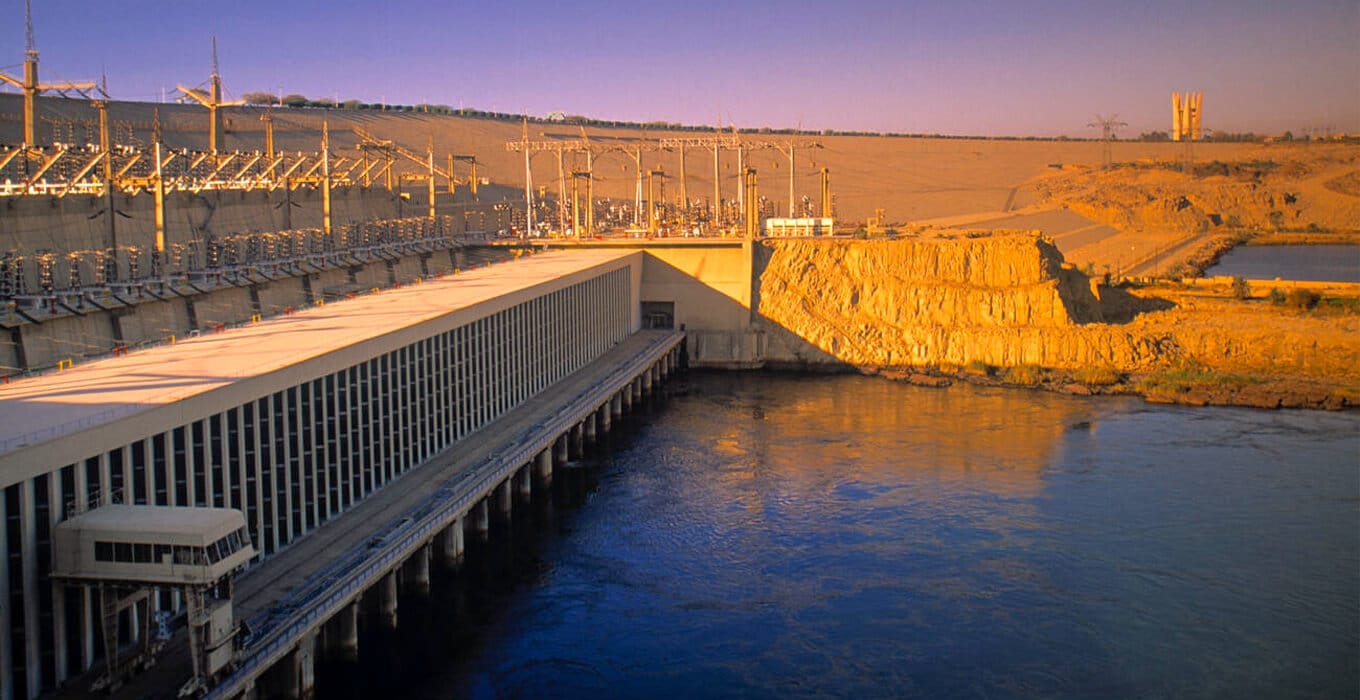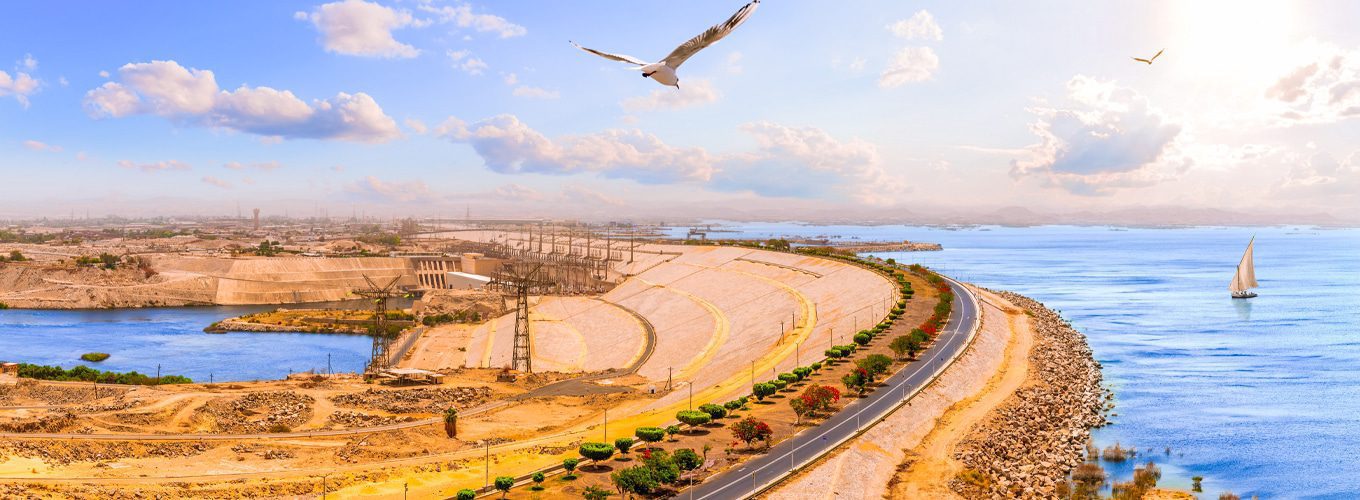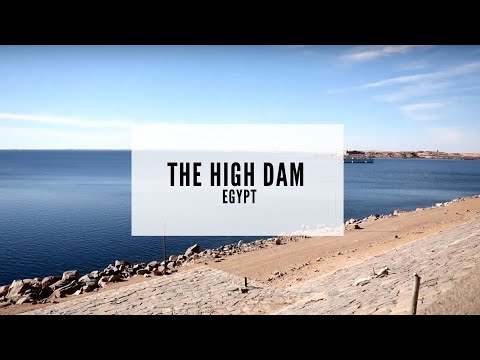The Aswan High Dam in Egypt is a true wonder of modern engineering. It’s one of the biggest dams in the world. It’s over 111 meters tall and 3.6 kilometers wide. This huge structure has changed the Nile River’s landscape, making Lake Nasser and helping Egypt with hydroelectric power.
This dam shows what humans can do with their skills and dreams. It’s a place everyone should see. It mixes ancient history with modern technology.
Key Takeaways
- The Aswan High Dam is an impressive engineering feat, standing over 111 meters tall and spanning 3.6 kilometers wide.
- The dam has created the vast Lake Nasser and generates a significant portion of Egypt’s hydroelectric power.
- The Aswan High Dam is a popular tourist attraction, offering visitors the chance to marvel at its sheer scale and learn about its fascinating history.
- The dam has had a significant impact on the local environment and economy, controlling the Nile’s floods and facilitating irrigation for agriculture.
- Visiting the Aswan High Dam provides an opportunity to explore the rich cultural heritage of the Aswan region, including ancient monuments and Nubian villages.
Introduction to the Aswan High Dam
The Aswan High Dam is a huge engineering wonder in Aswan, Egypt. It was built in the 1960s to manage the Nile River’s flow. This helped make hydroelectric power and support irrigation. The dam stands tall at 111 meters and stretches 3,830 meters long.
It was made from 1960 to 1970, costing $1 billion. Over 100,000 people had to move for it. The dam made Lake Nasser, a huge lake with 5,250 square kilometers of water.
The dam’s key features are:
- A base width of 980 meters
- A spillway capacity of 11,000 cubic meters per second
- A maximum water depth in Lake Nasser of 130 meters
- A normal elevation of 183 meters
- 12 Francis turbines with a total installed capacity of 2,100 MW
- An annual generation capacity of 10,042 GWh (as recorded in 2004)

The Aswan High Dam changed Egypt a lot. It gives steady hydroelectric power and helps with irrigation over a big area. Its building was a huge engineering feat. It has changed the area around the Nile River in Aswan City.
The History and Construction of the High Dam in Aswan, Egypt
The Aswan High Dam took over a decade to build. It was finished in 1970. It was a huge project made by Soviet and Egyptian engineers. They worked hard to make it happen.
First, they built tunnels to move the Nile River away from the dam site. This let them work on the dam without the river getting in the way. Then, they used a special method to build the dam. They used lots of rock and soil to make it strong.
Overcoming Challenges
Building the dam was hard. It was far from cities, very hot, and dry. Plus, people worried about how it would affect the environment. But, the engineers came up with new ways to solve these problems.
- They had to make a whole new place for the dam, with roads, homes, and places for workers.
- The heat and dryness made building tough. So, they had to find special ways to build and use materials that could handle the weather.
- They also thought about how the dam would affect the land and people living downriver. They planned to fix problems like less soil for farming, big changes in farming, and moving people.
Even with all these problems, the Aswan High Dam is a huge success. It shows how smart and hard the Soviet-Egyptian team worked to make it happen.
The Impact of the Aswan High Dam on Egypt
The Aswan High Dam is a huge achievement in Egypt. It has changed the country’s landscape, economy, and people’s lives. This massive dam, finished in 1970 for about $1 billion, changed the Nile River’s flow. It brought both good and bad changes to the area.
One main goal was to stop the Nile’s yearly floods. Before the dam, floods would damage the land. The Aswan High Dam controls these floods with Lake Nasser, holding 169 billion cubic meters. This has made Egypt safer and helped with farming and growing crops.
The dam greatly helped with irrigation and farming. The Nile gives Egypt 96 percent of its water. The dam uses this water well, making a lot of electricity. It powers Egypt’s industries and homes with 10 billion kilowatt-hours every year.
But, the dam also had downsides. About 90,000 people had to move because of the dam. Also, the dam stopped the natural soil fertilizing from the Nile floods. This used to help the land grow food.
|
Impact |
Benefit |
Challenge |
|
Flood Control |
✓ |
|
|
Irrigation |
✓ |
|
|
Hydroelectric Power |
✓ |
|
|
Relocation of People |
✓ |
|
|
Loss of Natural Fertilization |
✓ |
The Aswan High Dam changed Egypt in big ways. It helped with floods, farming, and power. But, it also caused social and environmental problems. These issues are still being worked on by Egypt’s leaders and experts.
Visiting the Aswan High Dam: A Tourist Attraction
The Aswan High Dam in Egypt is a big hit with tourists from all over. Built from 1960 to 1970, it’s not just a key source of power and water for Egypt. It also gives visitors a chance to learn something new.
Guided Tours and Impressive Features
Guided tours at the Aswan High Dam let you see how it works up close. You’ll visit the power station to see huge turbines and learn how it makes electricity. The dam’s size will amaze you, standing 111 meters tall and almost 4 kilometers long.
Building the dam made Lake Nasser, one of the biggest man-made lakes. Now, it’s a spot for fishing, boating, and relaxing cruises.
“The Aswan High Dam is not just an engineering marvel, but a testament to the power of human ingenuity and determination.”
Tours here teach you about the dam’s history, how it was built, and its effects. You’ll hear about the challenges and the smart ways the Soviet-Egyptian team solved them.
If you like history, engineering, or just want to see something new, the Aswan High Dam is a top spot. It’s a great example of Aswan High Dam Tourism, Dam Tours, Engineering Marvel, and Educational Experience.
Nearby Attractions and Activities
Aswan is a city near the Aswan High Dam with lots to see and do. It’s known for its culture and beautiful nature. The dam is a big engineering feat.
Lake Nasser is a huge man-made lake made by the dam. Taking a boat on the lake shows off the dam, desert, and Nubian lands. The Philae Temple is another must-see. It’s a UNESCO site and was moved to save it from the lake.
The Abu Simbel Temple is another famous spot. It’s a huge temple built by Ramses II. It shows off ancient Egypt’s skill. The Nubian Museum in Aswan also has lots of artifacts from the Nubian people.

|
Attraction |
Ticket Price |
Operating Hours |
|
Philae Temple |
Adult: 450 EGP Student: 230 EGP Boat Ride: 500 EGP Pylon Panorama: 200 EGP |
7 am – 5 pm (June – September) |
|
Unfinished Obelisk |
Adult: 200 EGP Student: 100 EGP |
Open daily |
|
Nubian Museum |
Adult: 300 EGP Student: 150 EGP |
Open daily |
|
Felucca Boat Ride |
Approximately $70 USD per hour |
Flexible schedule |
For a full Aswan visit, check out the historic Sofitel Old Cataract Hotel. It’s a 5-star place where famous people like Winston Churchill and Princess Diana stayed. You can also take day trips to temples like Kom Ombo and Edfu to learn more about the area’s culture.
High Dam in Aswan, Egypt: A Marvel of Engineering
The Aswan High Dam in Egypt is a huge engineering wonder. It changed the country’s landscape, power, and water use. Built in the 1960s with help from the Soviet Union and Egypt, it’s 111 meters high and 3.6 kilometers long.
This dam’s size is amazing, but its effects on Egypt are huge. It has 12 hydroelectric turbines that make 10 billion kilowatt-hours of electricity a year. This powers a lot of Egypt’s industry and homes, making energy cheaper.
The dam does more than just make power. It controls the Nile River’s flow, changing water management in Egypt. This has helped with better irrigation, flood control, and navigation. These changes have boosted Egypt’s farming and economy.
Building the dam was hard. Over 100,000 people had to move because of it. But the dam is now a big success, helping Egypt and its people a lot.
The Aswan High Dam’s impact is huge. It shows what people can do with hard work and smart ideas. Its big size and big effects on Egypt’s energy and water are truly amazing.
Getting to the Aswan High Dam
Visiting the Aswan High Dam in Egypt has many ways to get there. You can choose to dive into local life, enjoy a comfy ride, or go for easy travel. Each option fits different needs and plans.
Local Buses
Local buses are a cheap way to see the Aswan High Dam. They let you see everyday life and the area’s beauty. But, remember, their times can be unpredictable, and they might not be as comfy as other choices.
Taxis
Taxis are a comfy and easy way to get to the dam. You’ll need to agree on the price first. It’s a good pick if you want a private trip straight to the dam.
Organized Tours
Organized tours make visiting the dam easy and worry-free. They come with guides who know lots about the place. This is super helpful during busy times when planning is key.
It’s a good idea to plan your trip to the Aswan High Dam early, especially when it’s busy. This makes your visit smooth and fun as you see this amazing spot in Aswan, Egypt.
|
Transportation Option |
Advantages |
Considerations |
|
Local Buses |
Budget-friendly, Opportunity to experience local culture |
Less predictable schedules, Lower comfort level |
|
Taxis |
Comfortable, Convenient, Private transfer |
Prices may need to be negotiated |
|
Organized Tours |
Hassle-free, Knowledgeable guides, Convenient for peak seasons |
May be more expensive than independent travel |
Environmental and Social Impacts
The Aswan High Dam has many benefits for Egypt but also big environmental and social issues. Building the dam made Lake Nasser, causing more sediment. This has hurt the soil’s nutrients on the Nile’s floodplains. Farmers in the area now face harder times.
Also, over 100,000 people, including Nubians, had to leave their homes. They lost their land and culture. Now, they live in new places, trying to adjust.
The dam’s effects on nature are still being studied and talked about. It has helped Egypt’s economy and kept things stable. But, its effects on the environment and people are worrying.
|
Impact |
Details |
|
Sedimentation |
The dam has caused a buildup of sediment behind it, known as Lake Nasser, which has reduced the amount of nutrient-rich silt deposited on the Nile’s floodplains, impacting the productivity of agricultural lands. |
|
Nubian Relocation |
The creation of the reservoir required the relocation of over 100,000 people, including Nubian communities, who were displaced from their ancestral lands. |
|
Agricultural Impacts |
The reduction in nutrient-rich silt deposition has posed challenges for farmers, impacting the productivity of agricultural lands in the region. |
The Aswan High Dam is seen as a great feat of engineering. Yet, its effects on the environment and people are big. We need more research and talks to make sure it’s good for the future.
Tips for Visiting the Aswan High Dam
Planning a trip to the Aswan High Dam? Here are some important tips. Try to visit in the morning or late afternoon to skip the hot midday sun. Don’t forget to bring a hat and sunglasses for sun protection.
Wear comfy shoes because you’ll be walking a lot. The Aswan High Dam is a huge feat of engineering. Make sure you have enough time to see everything. Also, check out the Nubian Museum nearby to learn more about the area’s history and culture.
- Time your visit for the morning or late afternoon to avoid the midday heat.
- Wear comfortable, sun-protective clothing and footwear.
- Allow plenty of time to explore the dam and nearby sites like the Nubian Museum.
With good planning, your visit to the Aswan High Dam will be unforgettable. This place shows how humans and nature work together. It’s a chance to see Egypt’s past and present.
Conclusion
The Aswan High Dam is a huge success in Egypt. It controls the Nile River’s flow. This has led to more hydroelectric power, better irrigation, and flood control. It also helps protect ancient Egyptian sites.
But, the dam has faced problems like poor water quality, diseases, and people losing their homes. Still, it’s a symbol of human creativity and a key spot for tourists. Visitors get to see the huge dam and learn about its design and history.
The dam is 111 meters tall, 3,830 meters long, and 980 meters wide. It’s a modern wonder. The dam will keep helping Egypt with energy and water, but fixing its issues is important. We celebrate its past and its big impact on Egypt and its people.
Read our related articles:


